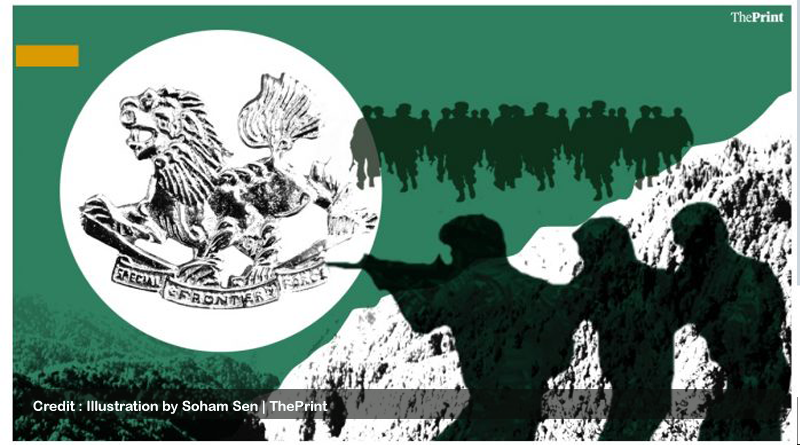All about Special Frontier Force, the secretive Indian unit in news after Ladakh clash
SFF, primarily drawn from Tibetan refugees, was formed in the immediate aftermath of the 1962 war with China. It has been a part of many important ops, from 1971 war to Kargil.
New Delhi: News from the Line of Actual Control (LAC) in Ladakh this week included reports of a Tibetan trooper’s death in a blast at Pangong Tso, one of the sites of tensions between India and China.
The reports of Tenzin Nyima’s death in a landmine blast, and the emergence of images showing his body wrapped in the Indian and Tibetan flags, brought focus on an extremely secretive security force comprising trained mountain warriors.
Nyima was a member of the Special Frontier Force (SFF), an Indian security unit that is primarily drawn from the thousands of Tibetan refugees who now call India home. It was formed in the immediate aftermath of the 1962 war with China, which resulted in a defeat for India.
The SFF has played an important role in multiple military operations — from the 1971 India-Pakistan war to the 1999 Kargil battle — but has largely functioned under the shadows.
Such is the secrecy around the SFF that a member of Tibet’s Parliament-in-exile reportedly said after Nyima’s death that it was about time India acknowledges the role they play.
SFF troopers, it is learnt, are among the additional personnel rushed to the border as tensions with China fester for five months and counting. China has not been too pleased about the reports, wary as it has been about the Tibetan government-in-exile and spiritual leader Dalai Lama setting up base in India after their escape in the wake of a failed uprising against Chinese occupation in 1959.
Not much is known about the force, but military experts say it comprises men as well as women, and receive the same training offered to elite commandos.
Birth of SFF
Initially known as Establishment 22, the SFF was raised by an Army officer named Major General Sujan Singh Uban. In an interview to India Today, Tibetologist Claude Arpi said the force was the brainchild of former Intelligence Bureau director B.N. Mullick and the US intelligence agency CIA.
With the wound of occupation still fresh, many Tibetans volunteered for the force when approached by India, and the SFF soon had 6,000 members. Arbi suggested there was a plan at the time to free Tibet, but that never materialised.
SFF units, also known as Vikas battalions, come under the direct purview of the Cabinet Secretariat, and is operationally involved with the Army. The force and is headed by a Major General rank Army officer, who serves as Inspector General of the SFF.
The SFF is based in Chakrata, Uttarakhand, and its insignia is a snow lion. The exact strength of the force right now could not be determined.
Speaking to ThePrint on the condition of anonymity, a source in the security establishment said both men and women soldiers in the SFF are “highly motivated and trained special forces personnel”. Their training, the source added, is akin to that imparted to commandos and special forces.
“They are trained extensively in various aspects of mountain warfare and are mostly deployed as part of India’s defence against China, but details of most of their operations are classified,” the source said.
A former Army officer, who also sought anonymity, said SFF personnel are elite forces known to be trained in high-altitude warfare and are excellent mountain warriors.
Lt Gen. Satish Dua (Retd), former head of the Integrated Defence Staff, said the Indian Army follows a concept of deploying scouts regiments comprising local residents for mountainous and border areas.
“This is because local residents are most suited to work and operate in high altitude and rugged terrain with harsh climate,” he added.
“They also have knowledge of ground and customs and language. We have Arunachal scouts, Dogra scouts, among others. Similarly, in the Ladakh region, because they know the terrain well. The SFF also has a substantial percentage of Tibetan refugees who want to serve voluntarily and are gainfully employed in the terrain that they are suited for,” he said.
Asked about the dual control of the SFF, he said, “We have different forces under different verticals. The central armed police forces involved in border-guarding duties don’t come under the Ministry of Defence (MoD) but under the Ministry of Home Affairs (MHA). The SFF has a separate control because it also has Tibetan refugees and involves another country. However, when they operate, they all work in synergy with each other.”
Major operations
The notable operations in which the SFF has participated include the 1971 war between India and Pakistan for the liberation East Pakistan or present-day Bangladesh. In that war, SFF battalions were deployed next to the Chittagong Hill Tracts — a hilly area as the name suggests — that lie to the southeast of East Pakistan. They were tasked with attacking enemy positions to aid the Indian Army’s operations.
In the operation, which was codenamed ‘Eagle’, they infiltrated into Bangladesh for guerrilla campaigns to attack enemy soldiers, military infrastructure, communication lines, logistics and weapons supplies.
They also prevented Pakistani troops from escaping into Myanmar, according to a piece on the website of the Delhi-based think-tank Observer Research Foundation (ORF),
“Their entire involvement, under the cover of plausible deniability with the R&AW’s blessings, was to train Bengali freedom fighters and conduct special operations against Mizo and Naga insurgents,” states the article.
The SFF soldiers were awarded for their bravery for their role in the 1971 war.
The Vikas battalions also played a critical role in the 1984 Operation Blue Star — when Indian forces laid siege to the Golden Temple in Amritsar to counter Sikh militants — and the capture of Siachen Glacier in 1984, besides the Kargil battle of 1999.
The first public acknowledgement of its existence reportedly came after SFF personnel participated in an abortive operation with the CIA in 1965 to place a nuclear-powered device on Mount Nanda Devi to monitor China’s nuclear weapons tests.
‘To fight for country’
In the blast that led to SFF trooper Nyima’s death, another member of the force was injured.
Teshi Tanzin, the latter’s father, later told India Today that the majority of Tibetan youngsters strive to join the defence forces. “There is a reason and aim for this… To fight for the country,” he said.
Courtesy:
https://theprint.in/defence/all-about-special-frontier-force-the-secretive-indian-unit-in-news-after-ladakh-clash/496660/



